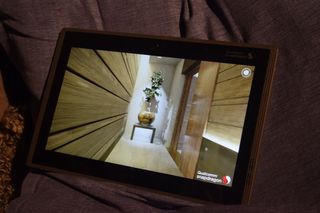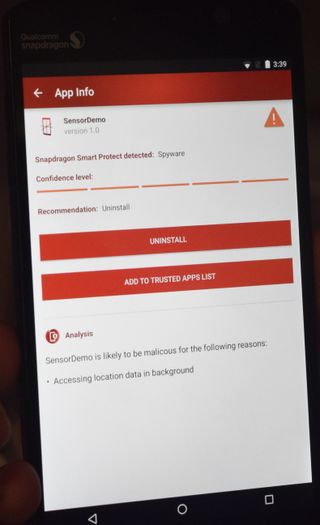The Software Behind The Dragon: What's On The Snapdragon 820 SoC
Although the Snapdragon 820 SoC got the top billing, the new software that Qualcomm has developed for use in conjunction with the new SoC really stole the show.
Immersive Audio Software
Much of the new software Qualcomm developed is focused on VR, as part of Qualcomm's ongoing initiative to attract companies working on virtual reality hardware. Qualcomm opted to use two speakers with individually connected amps in conjunction with a WSA8815 audio codec and Qualcomm's Immersive software technology to create a surround sound audio experience.

Qualcomm demonstrated this technology on one of its prototype tablets. When the audio was enabled, there was clearly a notable improvement in the overall audio quality and the depth of the sound, and the actual volume of the audio also increased. Although according to the ear test it was still below what a high-end gaming headset designed for surround sound audio output is capable of, and even further below a true surround sound system, it was notably better than what you would expect out of the typical smartphone or tablet.
Qualcomm also claimed that this software can help avoid damage caused to speakers when they are pushed to generate audio above a certain point. The company went on to claim that the increase in power consumption from the use of this technology is minimal, as it uses the Snapdragon 820's DSP to do much of the necessary software calculations.
EcoPix, TruPalette and LLV
Two other pieces of software that can be used to increase the immersive feeling of videos on a device using the Snapdragon 820 are EcoPix and TruPalette. EcoPix uses a light sensor in order to detect the light levels present around the user and makes changes to the video being displayed as needed. If the user is in a dark environment and playing a game, then the game will appear to be darker, as though it were night, or appear to be brighter during the day. This adds a sense of realism to the game, as it creates the illusion of being the same time of day as you.

The TruePalette software works to increase the video quality by enhancing the color and detail. The software also has an efficient tone mapping ability, which can create more realistic reflections.
These technologies don't only apply to videos and games rendered by the device, but also to pictures taken with it, adjusting brightness and color to produce a more realistic high-quality image. Qualcomm claimed that EcoPix can also reduce LCD or AMOLED power consumption by up to 30 percent. Both of these technologies take advantage of the VPU and DPU inside of the SoC to accelerate processing.
Stay on the Cutting Edge
Join the experts who read Tom's Hardware for the inside track on enthusiast PC tech news — and have for over 25 years. We'll send breaking news and in-depth reviews of CPUs, GPUs, AI, maker hardware and more straight to your inbox.

Although it isn't used to enhance games being rendered on the device, Qualcomm also showed off its Low Light Video (LLV) technology. This software helps to improve the lighting while recording videos to create more realistic results. It can also reduce distortion in images and can be applied to videos already recorded to clean up the project afterwards.

The last technology that Qualcomm demonstrated related to the camera was used for image recognition. By aiming the camera at something, the camera can identify different objects by comparing them to a database of similar objects with some degree of accuracy. This is based on deep learning technology, and you can create new categories for images inside of the software in order to search for images not included inside of the basic database. You can also search collections of photos for objects in the photo. A Qualcomm representative said that the technology had not been tested for use with individual people -- for example, it couldn't recognize a famous person in a photo -- but it was theoretically possible in conjunction with several of these pieces of software, and it may become possible in the future.

Security Software
Qualcomm also showed off three security software technologies. The Sense ID technology is essentially a very sensitive fingerprint scanner. It can scan through glass, plastic and metal, and it's detailed enough to read individual pores in your skin or small specs of dirt. Qualcomm claimed that, unlike other fingerprint scanners that won't work if you have water or other material on your fingers, this technology can detect your fingerprint without issue regardless of how clean your hands are.

Qualcomm's SafeSwitch technology is another technology for locking your smart devices remotely in case it has been stolen or lost.

Possibly the most useful of these new security technologies is Snapdragon Smart Protect, which is essentially a powerful real-time protection antivirus software, capable of catching malicious apps before they cause serious problems. It can monitor what applications attempt to do on your devices as well; if a malicious app attempts to send unwarranted text messages or access your private information, then Smart Protect will lock down the app and inform you that the app was trying to do something it shouldn't. You can then take further action to remove the malicious software using Smart Protect.
Improving Signal Strength
The last major area in which Qualcomm has developed software for the Snapdragon 820 has to do with the antenna. Qualcomm claimed the new technology was capable of increasing the signal strength and improving voice quality on calls made in areas with poor cell service. The company also claimed that this would increase battery life by 20 percent, as the antenna does not have to work as hard to maintain the connection.
All of these software technologies are supported on the Snapdragon 820 and can be licensed by Qualcomm for use on devices using the SoC. Devices using the Snapdragon 820 are expected to start appearing on the market some time in the first half of 2016.
______________________________________________________________________

Michael Justin Allen Sexton (or MJ) is a Contributing Writer for Tom's Hardware. As a tech enthusiast, MJ enjoys studying and writing about all areas of tech, but specializes in the study of chipsets and microprocessors. In his personal life, MJ spends most of his time gaming, practicing martial arts, studying history, and tinkering with electronics.
Follow Michael Justin Allen Sexton @EmperorSunLao. Follow us on Facebook, Google+, RSS, Twitter and YouTube.
Most Popular


